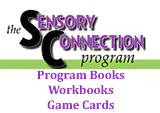Sensory Kits for Coping and Calming
A Sensory Kit is a collection of items that can be kept handy for the use of patients or staff. Items for the kit are chosen according to the needs of patients or clients in a particular setting. Patients are encouraged to experiment using the various items to determine what they find useful for calming and alerting. The Kit can be in a basket, box, or suitcase. In order for the items in the kit to be used effectively staff members must be trained in the use of sensory modalities.
Developing Sensory Kits is one of the sensory activities featured in the Sensory Connection Program Books. Further directions and suggestions are provided in the Manual and Handbook.
Kit for an Outpatient Mental Health Group
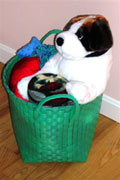 The kit pictured to the right was developed for an outpatient treatment group. The items are offered to patients when they arrive to help them settle down and become comfortable for the group discussion.
The kit pictured to the right was developed for an outpatient treatment group. The items are offered to patients when they arrive to help them settle down and become comfortable for the group discussion.
Items include a "Heavy Duty Dog," a fleece lap blanket, a foot roller, a squishy soft pillow, a Koosh, several beanbags, a scented hand cream, several stress balls, and an assortment of hard candies and gum.
Kit for an Inpatient Acute Psychiatric Unit for Adults
The kit pictured is an example of sensory supplies that are kept handy for the use of patients in an acute mental health unit. It is usually used when patients are feeling agitated, frightened, or on the verge of losing self-control. Items are also offered to patients who are feeling suicidal or are at risk for self-injurious behavior.
When they arrive on the unit, patients identify items and sensory strategies they believe will be helpful. Sensory interventions are used most often by the 3 -11 p.m. shift. This seems to be the time when patients have the most trouble and when the most incidents of restraints occur. Staff members receive training on the use of sensory modalities in order to use these items safely and effectively.
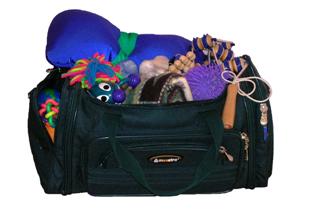
Kit items include a soft silky pillow, lap blanket, various massagers including a favorite one which is shaped like a bug and vibrates, a selection of Kooshes and stress balls, a selection of scented hand creams, a smell canister (used for grounding), hot balls (used for grounding, and exercise bands (used to provide strong Proprioceptive input).
Activity Focused Kit for an Inpatient Mental Health Unit
 This kit is kept handy for patients who are able to calm down when they are involved in an activity which requires focus. These activities should be available for patients to use any time during the day when they feel upset or anxious. Most of these activities require a fairly high cognitive level except for the coloring and painting activities. Many "adult" oriented art and coloring books are now available on the market.
This kit is kept handy for patients who are able to calm down when they are involved in an activity which requires focus. These activities should be available for patients to use any time during the day when they feel upset or anxious. Most of these activities require a fairly high cognitive level except for the coloring and painting activities. Many "adult" oriented art and coloring books are now available on the market.
Dover publishes many detailed coloring books from nature themes to National Parks. www.doverpublications.com
Nasco Senior Activities Catalog also has many selections.
Kit items include the Amaze Game, a crossword puzzle book, a word search book, water color art pencils and art paper, adult coloring book, a book of poetry, and a book of animal and nature photographs.
Personal Kit Developed for Individual Needs
 This type of kit is developed by a client in collaboration with a therapist. The patient explores various sensory items to determine what items might be useful to help with self-regulation during the day. Items are kept in a fanny pack that the person can take to work, appointments, and other outings and daily activities. Items in a personal kit will vary widely depending on the person's issues and the type of situations that require self-regulation strategies. This particular kit contains scented hand cream, beanbag, fidget widgets, stress ball, gum, candies, a water bottle, and a book of crossword games.
This type of kit is developed by a client in collaboration with a therapist. The patient explores various sensory items to determine what items might be useful to help with self-regulation during the day. Items are kept in a fanny pack that the person can take to work, appointments, and other outings and daily activities. Items in a personal kit will vary widely depending on the person's issues and the type of situations that require self-regulation strategies. This particular kit contains scented hand cream, beanbag, fidget widgets, stress ball, gum, candies, a water bottle, and a book of crossword games.
Making Your Own Sensory Supplies
Many therapists have asked about ways to obtain supplies at a reasonable price. One way to cut down on costs is to make items. Involve patients in making their own supplies whenever possible. It helps them become more invested in the treatment process and it can be a very meaningful activity. Please note that I attempted to make a weighted blanket using feed corn as a filler. I found it difficut to maneuver the blanket on the sewing machine once it became heavier. I would not suggest trying this unless you are experienced in sewing.
Beanbags for Tapping
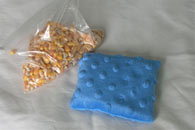 Beanbags are used often in the Sensory Connection Program to provide deep pressure touch. For suggestions on the use of tapping refer to the Sensory Connection Program Books. Beanbags can also be held like a stress ball or used in games.
Beanbags are used often in the Sensory Connection Program to provide deep pressure touch. For suggestions on the use of tapping refer to the Sensory Connection Program Books. Beanbags can also be held like a stress ball or used in games.
Directions:
Cut two four inch squares of durable fabric such as denim or corduroy. Place right sides together and sew 1/2" from the edge around the square leaving a small opening for stuffing. Turn the bag right-side out and stuff with beans or seed corn. The seed corn shown here next to the beanbag can be purchased in bulk at a store that sells feed for animals. It is inexpensive and makes a good filling.
Heavy Duty Dog
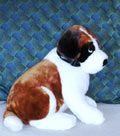 The weight of this stuffed animal makes it feel very real and it causes a very calming response when held on the lap. Patients enjoy it and it often sparks discussion of past pets. Cats make good "heavy duty" pets as well.
The weight of this stuffed animal makes it feel very real and it causes a very calming response when held on the lap. Patients enjoy it and it often sparks discussion of past pets. Cats make good "heavy duty" pets as well.
Directions:
Purchase a realistic looking stuffed dog or cat. Make a slit along a seam on the bottom of the animal and remove most of the stuffing. Leave a little stuffing for softness at the ends of the paws and the nose area. Fill the animal with seed corn which can be purchased at a grain store. Once the stuffing is replaced the opening is hand sewn closed. A large dog weighs 8 - 10 pounds.
Spandex Hug
This stretchy band of Spandex provides comforting deep pressure touch to the upper body. The band of Spandex is wrapped around the back and shoulders and then crossed in front to produce a firm "hug" effect that is very calming.
Directions:
 Purchase 18" of a Spandex knit fabric which usually comes in a 60" width. This fabric has a 4-way stretch and is sometimes sold under the brand name of Lycra. It is often used to make swimsuits. Fold the fabric so that the two salvage edges meet and sew these edges together. Reinforce seam. You should now have an 18" tube which when laid flat measures 18" by 30". The spandex is used in this double layer rectangle and wrapped around the body from the back as pictured.
Purchase 18" of a Spandex knit fabric which usually comes in a 60" width. This fabric has a 4-way stretch and is sometimes sold under the brand name of Lycra. It is often used to make swimsuits. Fold the fabric so that the two salvage edges meet and sew these edges together. Reinforce seam. You should now have an 18" tube which when laid flat measures 18" by 30". The spandex is used in this double layer rectangle and wrapped around the body from the back as pictured.
Cozy Comforter
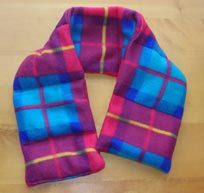 This weighted shoulder pad is placed around the neck and it provides deep pressure touch and is very calming. It can be heated in the microwave for 1 minute to make it warm. It can be placed in the bed to warm it or used on aching muscles. Surface clean only.
This weighted shoulder pad is placed around the neck and it provides deep pressure touch and is very calming. It can be heated in the microwave for 1 minute to make it warm. It can be placed in the bed to warm it or used on aching muscles. Surface clean only.
Directions:
Cut a 6" piece of 60" fleece fabric. Fold with right sides together. Sew 2 edges making a 30" tube using 1/2" side seams, leave one end open. Turn right side out. Pour 2/3 cup of rice into the tube, sew across tube 5" from bottom, trapping rice in first block. Pour another 3/4 cup of rice into tube and sew again 5" above first block. Continue making 6 blocks. Turn edges of top down and sew across to finish last block.
